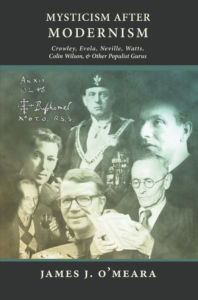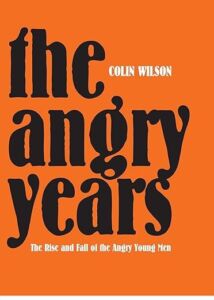Colin Wilson’s The Angry Years
Colin Wilson
The Angry Years: The Rise and Fall of the Angry Young Men
London: Anova Books, 2007
When Colin Wilson sat down in 2006 to write his own history of the “Angry Young Men,” it was mainly a matter of settling accounts. There had been at least two other similarly-named books on the subject, and they were informative and entertaining.[1] But they mostly retold familiar tales that had run in the London press, from 1956 onward, usually with Wilson himself as a central figure. Here we have a final, synoptic gospel where the popular old prophet himself is doing the telling, and there aren’t too many people left to contradict him.
The book was published in 2007. As Colin died in 2013, he did us a signal service in getting these confusing and often pointless stories sorted out and down on paper while he had the time and energy.
I’m talking about well-worn Angry Young Man tales that got recycled in the press, mainly in 1956-58, ones that usually turn out to more silly than substantial. For example, there’s that Royal Court pub brawl. It seems that in early 1958 Kenneth Tynan and friends loudly walked out on a new, and rather bad, play. It was a play by Wilson’s friend Stuart Holroyd and was having its first (and maybe only) night at the Royal Court Theatre.[2] According to some accounts, Sir Oswald Mosley was in the audience. There was a fracas afterwards. Not only did it make the London morning papers, the story found its way to New York, even turning up in Time magazine with the headline, “Sloane Square Stomp.”
It was hardly a brawl, in Wilson’s telling. Holroyd, Wilson, and friends simply repaired to a pub for some chatty drinks after the play. Someone told them that Kenneth Tynan, Christopher Logue,[3] and other miscreant theater-leavers were at a drinking hole nearby. So Wilson et al. traipsed off to that nearby pub, where Holroyd’s wife grabbed Logue by the throat and knocked him off his chair. Whereupon the pub’s landlord told them to leave.
They went to a friend’s nearby flat, where Bill Hopkins telephoned his brother and other newspapermen around town. Colin Wilson heard him in the next room. “Is that the Daily Mail? Have you heard about this brawl outside the Royal Court? . . . Well there was Stuart Holroyd, Colin Wilson, Bill Hopkins . . .”[4]

You can buy James J. O’Meara’s Mysticism After Modernism here.
Not much of a story, is it? But newsworthy, if you make it so. I first heard these recollections from Bill Hopkins and Colin Wilson 30-odd years ago. It was like being a little kid overhearing turn-of-the-century scandals about Aunt Petunia. It all made very little sense to me.
But the Royal Court brawl story reminds me of something Bill Hopkins told me much later. He was walking through Covent Garden with a girlfriend a year or so later when they passed a familiar face: that selfsame Christopher Logue. Reflexively, Bill said hello. Logue said nothing and passed on. The girlfriend hissed in Bill’s ear: “He hates you!”[5] Well, Bill was oblivious. The idea of someone holding a grudge because of a facetious media event was beyond him.
Rather like the tales of how Colin Wilson often slept rough in Hampstead Heath, and spent his days writing and researching at the British Museum’s Reading Room. His Hampstead Heath days were pretty much behind him by this time, but Life magazine quickly assigned a crack photographer to follow Wilson around with a Rolleiflex, catching him on his bicycle, posing with a mug of tea in his bedsit, and reading a book on the Heath while half snuggled-up in his “waterproof sleeping bag” (which he now had little need of, as he was now a successful writer living in cramped accommodations in Notting Hill). Colin was happy to comply, but somewhat puzzled by later accusations that he was a fraud because he no longer slept rough in Hampstead Heath.
Another thrice-told tale is the one about Kingsley Amis receiving a bottle of whisky from Colin but refusing to drink it because (he said) he was scared of Wilson and feared it might be poisoned:
I was too afraid to drink a bottle of whisky Colin Wilson once gave me, and there it stayed on my shelf till an intrepid psychiatrist pal guzzled it with no ill effects, or none but the usual.[6]
According to Wilson, the whisky was a gift from him back in 1957 when he and then-girlfriend, future wife Joy Stewart, were on the run from the press, and Joy’s parents (who had literally tried to horsewhip the brilliant young author of The Outsider). While they eventually ended up in Cornwall, where they lived for many years, they stopped for a bit at Amis’ house in Swansea, where Amis was then teaching. Wilson assures us the whisky could not have been poisoned, as obviously the seal had not been broken.
Kingsley Amis, and his lifelong friend Philip Larkin, figure hugely in The Angry Years, which came out when both had been safely dead for a decade or more. (Amis died in 1995, Larkin in 1985.) Amis was a neurotic who didn’t drive and was afraid to fly. He got his inspiration for his novels’ sex escapades from Larkin’s masturbatory fantasies and real-life adventures.
I see here a good argument for living to a ripe old age, or at least to one where your potential enemies are dead and you won’t be contradicted.
Wilson sets us up at the beginning with a synopsis-outline “Analytical Table of Contents” of what the chapters are going to be about. This front-of-book apparatus lets you home in on what you’re looking for, as you slide back and forth in his narrative. No doubt this began as the author’s own aide-memoire (as in, what do we write about next?). And then decided, once his typescript was almost done, that it would be quite as readable and useful for the general audience, and thus included it at the front of the book. The format is a great guide for any biography or popular history, and I’d like to see more of it.
Anyway, here is a smidgen of that outline. From an early chapter that mainly describes, or disses, Kenneth Tynan:
2. He That Plays the King
Tynan at Oxford. ‘Have a care for that box, my man — it is freighted with golden shirts.’ His taste for masturbation and female posteriors. He begins to write theatre reviews. His pornography collection. ‘Just a thong at twilight.’ He marries Elaine Dundy. She objects to being flogged. His career as a director stalls . . .
Tynan, of course, was long passed from the scene by this point (died in 1980, age 53, of emphysema) and couldn’t object to this.
Wilson has a lot of fun with Tynan’s famous concluding puff on the John Osborne play:
I doubt if I could love anyone who did not wish to see Look Back in Anger. It is the best young play of its decade.
Ridiculous, of course. Kenneth Tynan did not love much of anything besides showing off, and smacking young ladies’ bare bottoms with canes. Tynan’s career, at Oxford and after, mostly consisted of sneering and lambasting whatever he saw on stage. Now Tynan was praising this new playwright to the skies, not because he loved Osborne’s talent but because it gave him an opportunity to get back at all the actors and theater managers he had offended, people who had got him sacked from the newspapers he was reviewing for.
At least that’s Colin Wilson’s reading, and it seems plausible enough.
Notes
[1] I recommend both of the other books I know, which are available at the Internet Archive. The first was Kenneth Allsop’s The Angry Decade: a Survey of the Cultural Revolt of the Nineteen-Fifties (1958), a book that Colin Wilson liked, though he remarked that it should really be called The Angry Eighteen Months . . . since Allsop got it out in a hurry! In such a hurry that Allsop greatly revised it six years later, when there was a lot more news to tell. Allsop was a silver-haired, silky-voiced, very handsome television presenter on the BBC in the 1960s. He made such an impression on the young Tom Wolfe that when Wolfe was journeying in England in the mid-‘60s, Allsop briefly appeared in one of Wolfe’s Sunday-supplement articles in a London weekend paper. It seems some snooty Cambridge lads were watching Allsop on the telly and one remarked that poor Allsop would “never get the Midlands out of his voice.” Allsop was actually from Yorkshire. The article appears as “The Mid-Atlantic Man” in Wolfe’s The Pump House Gang, 1968. Besides being a television talking-head, Allsop was also a readable and prolific journalist and literary critic who published over 15 books before dying in his early 50s from a barbiturate overdose.
Humphrey Carpenter’s The Angry Young Men: A Literary Comedy of the 1950s (2002) gave Colin Wilson less pleasure, as a lot of it is exploitation pop history. For example, Carpenter refers to Bill Hopkins and Stuart Holroyd as Wilson’s “satellites,” and smacks his lips over the fall of Wilson’s shooting star after the dismal reception of his sequel to The Outsider, Religion and the Rebel. Carpenter takes gratuitous slams over some lines in Wilson’s Introduction, writing, “He concluded this opening chapter with what seemed to be a sinister promise that he would soon emerge as a new Oswald Mosley: ‘I am not necessarily a writer. The moment writing ceases to be a convenient discipline for subduing my stupidity and laziness, I shall give it up and turn to some more practical form.’” A bizarre put-down suggesting that Carpenter regarded Colin Wilson as a nostalgic joke, never mind that he was very much alive and well. Humphrey Carpenter had also written biographies of J. R. R. Tolkien and Dennis Potter, who by the time Carpenter got around to them were safely dead. “Totally out of sympathy with the writers he was discussing,” is Wilson’s summation in The Angry Years:
For Carpenter, the really significant movement of the mid-century was the satire trend that began with Beyond the Fringe and the television series That Was the Week that Was. By comparison . . . the ‘Angry Young Men’ were beneath serious consideration.
[2] The Royal Court Theatre often comes up in Angry Young Man stories, as it was the venue for Look Back and Anger and many other plays of that era, and many since. But is impossible to imagine if you don’t know it, as it is in an oddball location. Instead of being in the West End, by other legitimate theaters in London, it is at Sloane Square between Chelsea and Belgravia. For that reason, or whatever, it has always attracted offbeat, non-touristy productions. It appears in the Woody Allen movie, Match Point, because aspiring actress Scarlett Johansson is supposed to be auditioning there.
[3] Christopher Logue (1926-2011) was a poet, playwright, contributor to Private Eye, and sometime actor (according to Wikipedia he played a spaghetti-eating fanatic in Terry Gilliam’s Jabberwocky).
[4] Colin Wilson, The Angry Years.
[5] Postcard from Bill Hopkins, c. May 1993.
[6] Humphrey Carpenter, The Angry Young Men.




